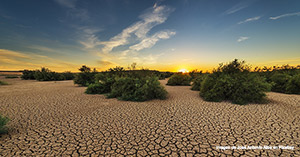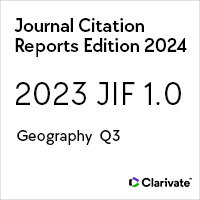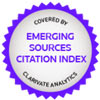La sequía: el mal silencioso de la migración centroamericana en el periodo 1990 a 2019
Drought: the silent evil of Central American migration in the period 1990 to 2019
https://doi.org/10.21670/ref.2403139
Palabras clave:
migración, sequia, corredor seco de Centroamérica, modelo de frontera, cambio climático, eventos climáticos extremosResumen
El objetivo es analizar en el periodo 1990 a 2019 los efectos del clima y la tendencia de los individuos a dejar un territorio al medir el peso que tiene la precipitación o la falta de esta en el Corredor Seco de Centroamérica. Para estudiar este proceso se desarrolló un modelo estocástico de frontera. Se encontró como resultado principal que se tiene una mayor tendencia a migrar cuando se presenta una sequía, entendida como un evento extremo para el ambiente y la sociedad. Esta propensión se evalúa con un sistema que incluye una serie de controles como eventos climáticos extremos como El Niño (ENOS) y huracanes, niveles de violencia, economía y tipo de cambio, que lleva a concluir que la sequía por encima de otro evento climático motiva a la población a migrar. Estos hallazgos permiten contribuir en el planteamiento de políticas de prevención, mitigación y resiliencia para cada evento climático.Abstract The objective is to analyze in the period 1990 to 2019 the effects of climate and the tendency of individuals to leave a territory, measuring the weight of precipitation or lack thereof in the Central American Dry Corridor. To study this process, a stochastic frontier model was developed. As a primary result, it was found that there is a greater tendency to migrate when a drought occurs, understanding it as an extreme event for the environment and society. This tendency is evaluated with a system that includes series of controls such as other extreme weather events such as El Niño (ENSO) and hurricanes, violence levels, economy and exchange rate, which leads to the conclusion that drought above any other climatic event motivates the population to migrate. These findings contribute to the formulation of prevention, mitigation and resilience policies.
Citas
Aguayo Lorenzo, E. (2011). Factores determinantes en modelos econométricos regionales de migración interna. Revista Galega de Economía, 20(número extraordinario). https://www.redalyc.org/articulo.oa?id=39121275009
Aigner, D., Knox Lovell, C. A. & Schmidt, P. (1977, julio). Formulation and estimation of stochastic frontier production function models. Journal of Econometrics, 6(1), 21-37. https://doi.org/10.1016/0304-4076(77)90052-5 DOI: https://doi.org/10.1016/0304-4076(77)90052-5
Arango, J. (2003, octubre). La explicación teórica de las migraciones: luz y sombra. Migración y Desarrollo, (1). https://www.redalyc.org/articulo.oa?id=66000102 DOI: https://doi.org/10.35533/myd.0101.ja
Arslan, A., Egger, E.-M. & Winters, P. (2019). Migration, demography, and agri-food systems. En R. Serraj & P. Pingali (Eds.), Agriculture and food systems to 2050. Global trends, challenges and opportunities (pp. 87-135). https://doi.org/10.1142/9789813278356_0003 DOI: https://doi.org/10.1142/9789813278356_0003
Baez, J., Caruso, G., Mueller, V. & Niu, C. (2017). Droughts augment youth migration in Northern Latin America and the Caribbean. Climatic Change, 140, 423-435. https://doi.org/10.1007/s10584-016-1863-2 DOI: https://doi.org/10.1007/s10584-016-1863-2
Barthel-Bouchier, D. (2013). Cultural heritage and the challenge of sustainability. Routledge. https://doi.org/10.4324/9781315431055 DOI: https://doi.org/10.4324/9781315431055
Battese, G. E. & Coelli, T. J. (1992). Frontier production functions, technical efficiency and panel data: with application to paddy farmers in India. Journal of Productivity Analysis, 3, 153-169. https://doi.org/10.1007/BF00158774 DOI: https://doi.org/10.1007/BF00158774
Battese, G. E. & Corra, G. S. (1977). Estimation of a production frontier model: with application to the pastoral zone of Eastern Australia. Australian Journal of Agricultural Economics, 21(3), 169-179. https://doi.org/10.1111/j.1467-8489.1977.tb00204.x DOI: https://doi.org/10.1111/j.1467-8489.1977.tb00204.x
Bauer, P. W. (1990, octubre-noviembre). Recent developments in the econometric estimation of frontiers. Journal of Econometrics, 46(1), 39-56. https://doi.org/10.1016/0304-4076(90)90046-V DOI: https://doi.org/10.1016/0304-4076(90)90046-V
Beine, M. & Jeusette, L. (2021). A meta-analysis of the literature on climate change and migration. Journal of Demographic Economics, 87(3), 293-344. https://doi.org/10.1017/dem.2019.22 DOI: https://doi.org/10.1017/dem.2019.22
Bekaert, E., Ruyssen, I. & Salomone, S. (2021). Domestic and international migration intentions in response to environmental stress: a global cross-country analysis. Journal of Demographic Economics, 87(3), 383-436. https://doi.org/10.1017/dem.2020.28 DOI: https://doi.org/10.1017/dem.2020.28
Caldes, G. (2019, 19 de marzo). La escasez hídrica no siempre es por la sequía. iAgua. https://www.iagua.es/blogs/gabriel-caldes/escasez-hidrica-no-es-sequia
Calvo-Solano, O. D., Quesada-Hernández, L., Hidalgo, H. & Gotlieb, Y. (2018, septiembre-diciembre). Impactos de las sequías en el sector agropecuario del Corredor Seco Centroamericano. Agronomía Mesoamericana, 29(3), 695-709. http://dx.doi.org/10.15517/ma.v29i3.30828 DOI: https://doi.org/10.15517/ma.v29i3.30828
Canales Cerón, A. & Rojas Wiesner, M. L. (2018). Panorama de la migración internacional en México y Centroamérica. Documento elaborado en el marco de la Reunión Regional Latinoamericana y Caribeña de Expertas y Expertos en Migración Internacional preparatoria del Pacto Mundial para una Migración Segura, Ordenada y Regular (Serie Población y Desarrollo 124). Cepal-IOM. https://www.cepal.org/es/publicaciones/43697-panorama-la-migracion-internacional-mexico-centroamerica
Carrasco, I. & Suárez, J. I. (2018). Migración internacional e inclusión en América Latina. Análisis en los países de destino mediante encuestas de hogares (Serie Políticas Sociales 231). Cepal-GIZ. https://www.cepal.org/es/publicaciones/43947-migracion-internacional-inclusion-america-latina-analisis-paises-destino
Cattaneo, C., Beine, M., Fröhlich, C. J., Kniveton, D., Martinez-Zarzoso, I., Mastrorillo, M., Millock, K., Piguet, E. & Schraven, B. (2019). Human migration in the era of climate change. Review of Environmental Economics and Policy, 13(2), 189-206. https://www.journals.uchicago.edu/doi/10.1093/reep/rez008 DOI: https://doi.org/10.1093/reep/rez008
Cavazos Hernández, M. (2021, agosto). Environmentally induced inter-municipal migration: the case for Guatemala [Tesis de maestría, Lund University]. LUP Student Papers. https://lup.lub.lu.se/student-papers/search/publication/9063825
Climate Change Knowledge Portal. (s. f.). Data catalog. World Bank https://climateknowledgeportal.worldbank.org/download-data
Desbureaux, S. & Rodella, A.-S. (2019). Drought in the city: the economic impact of water scarcity in Latin American metropolitan areas. World Development, 114, 13-27. https://doi.org/10.1016/j.worlddev.2018.09.026 DOI: https://doi.org/10.1016/j.worlddev.2018.09.026
Durand, J. & Massey, D. S. (2003). Clandestinos: migración México/Estados Unidos en los albores del siglo XXI. Miguel Ángel Porrúa/Universidad de Zacatecas. https://estudiosdeldesarrollo.mx/productos/clandestinos/
Førsund, F. R., Lovell, C. K. & Schmidt, P. (1980, mayo). A survey of frontier production functions and of their relationship to efficiency measurement. Journal of Econometrics, 13(1), 5-25. https://doi.org/10.1016/0304-4076(80)90040-8 DOI: https://doi.org/10.1016/0304-4076(80)90040-8
Gandini, L. (2020). Caravanas migrantes: de respuestas institucionales diferenciadas a la reorientación de la política migratoria. REMHU: Revista Interdisciplinar da Mobilidade Humana, 28(60), 51-69. https://doi.org/10.1590/1980-85852503880006004 DOI: https://doi.org/10.1590/1980-85852503880006004
García-Zamora, R., Pérez-Veyna, Ó., Foladori, G., Delgado-Wise, R., Moctezuma-Longoria, M., Reyes-Rivas, E., Márquez-Covarrubias, H. & Rivera-Castañeda, P. (2007). Paradojas de la migración internacional y el medio ambiente. Economía, Sociedad y Territorio, 6(24), 975-994. https://doi.org/10.22136/est002007244 DOI: https://doi.org/10.22136/est002007244
Gómez Walteros, J. A. (2010). La migración internacional: teorías y enfoques, una mirada actual. Semestre Económico, 13(26), 81-100. https://revistas.udem.edu.co/index.php/economico/article/view/266
Gray, C. & Wise, E. (2016). Country-specific effects of climate variability on human migration. Climatic Change, 135, 555-568. https://doi.org/10.1007/s10584-015-1592-y DOI: https://doi.org/10.1007/s10584-015-1592-y
Greene, W. H. (1993). The econometric approach to efficiency analysis. En H. O. Fried, C. A. Knox Lovell & S. S. Schmidt (Eds.), The measurement of productive efficiency and productivity change (pp. 92-250). Oxford Academic. https://doi.org/10.1093/acprof:oso/9780195183528.003.0002 DOI: https://doi.org/10.1093/acprof:oso/9780195183528.003.0002
Gustin, G. & Henninger, M. (2019, 9 de julio). Central America’s choice: pray for rain or migrate. NBC News. https://www.nbcnews.com/news/latino/central-america-drying-farmers-face-choice-pray-rain-or-leave-n1027346
Hartley-Ballestero, M. & Suárez-Espinoza, K. (2020). Exportación de servicios turísticos: ¿un sector estratégico para enfrentar el cambio climático en Costa Rica? Revista Escuela de Administración de Negocios, (edición especial 2020), 53-70. https://doi.org/10.21158/01208160.n0.2020.2738 DOI: https://doi.org/10.21158/01208160.n0.2020.2738
Hotez, P. J., Damania, A., & Bottazzi, M. E. (2020). Central Latin America: two decades of challenges in neglected tropical disease control. Plos Neglected Tropical Diseases, 14(3), Artículo e0007962. https://doi.org/10.1371/journal.pntd.0007962 DOI: https://doi.org/10.1371/journal.pntd.0007962
Huang, C. J., Huang, T.-H. & Liu, N.-H. (2014). A new approach to estimating the metafrontier production function based on a stochastic frontier framework. Journal of Productivity Analysis, 42, 241-254. https://doi.org/10.1007/s11123-014-0402-2 DOI: https://doi.org/10.1007/s11123-014-0402-2
Kaenzig, R. & Piguet, E. (2014). Migration and climate change in Latin America and the Caribbean. En E. Piguet & F. Laczko (Eds.), People on the move in a changing climate. The regional impact of environmental change on migration (pp. 155-176). IOM/Springer. https://link.springer.com/chapter/10.1007/978-94-007-6985-4_7 DOI: https://doi.org/10.1007/978-94-007-6985-4_7
Klein, N. (2015). This changes everything: Capitalism vs. the climate. Simon & Schuster.
Koubi, V. (2019). Climate change and conflict. Annual Review of Political Science, 22, 343-360. https://doi.org/10.1146/annurev-polisci-050317-070830 DOI: https://doi.org/10.1146/annurev-polisci-050317-070830
Koubi, V., Stoll, S. & Spilker, G. (2016). Perceptions of environmental change and migration decisions. Climatic Change, 138, 439-451. https://doi.org/10.1007/s10584-016-1767-1 DOI: https://doi.org/10.1007/s10584-016-1767-1
Leyk, S., Runfola, D., Nawrotzki, R. J., Hunter, L. M. & Riosmena, F. (2017). Internal and international mobility as adaptation to climatic variability in contemporary Mexico: evidence from the integration of census and satellite data. Population, Space and Place, 23(6), Artículo e2047. https://onlinelibrary.wiley.com/doi/10.1002/psp.2047 DOI: https://doi.org/10.1002/psp.2047
Lynch, C. (2019). The impacts of warming coffee: the climate change-coffee-migration nexus in the Northern Triangle of Central America. Independent Study Project (ISP) Collection 3008. https://digitalcollections.sit.edu/isp_collection/3008
Lynn, J. & Peeva, N. (2021). Communications in the IPCC’s sixth assessment report cycle. Climatic Change, 169(18). https://doi.org/10.1007/s10584-021-03233-7 DOI: https://doi.org/10.1007/s10584-021-03233-7
Maretti, M., Tontodimamma, A. & Biermann, P. (2019). Environmental and climate migrations: an overview of scientific literature using bibliometric analysis. International Review of Sociology, 29(2), 142-158. https://doi.org/10.1080/03906701.2019.1641270 DOI: https://doi.org/10.1080/03906701.2019.1641270
Martin, S. F., Bergmann, J., Wyss, H. & Rigaud, K. K. (2018). Environmental change and human mobility: perspectives from the World Bank. En R. McLeman & F. Gemenne (Eds.), Routledge handbook of environmental displacement and migration (pp. 408-414). Routledge. https://doi.org/10.4324/9781315638843 DOI: https://doi.org/10.4324/9781315638843-32
Martínez Sanesteban, I. (2020). Refugiats i refugiades ambientals: una revisió sistemàtica [Trabajo final de grado, Universitat Autònoma de Barcelona]. DDD UAB. https://ddd.uab.cat/record/232763
Meeusen, W. & Van Den Broeck, J. (1977, junio). Efficiency estimation from Cobb-Douglas production functions with composed error. International Economic Review, 18(2), 435-444. https://doi.org/10.2307/2525757 DOI: https://doi.org/10.2307/2525757
Migration Policy Institute (MPI). (s. f.). Migration data hub. https://www.migrationpolicy.org/programs/migration-data-hub
Nawrotzki, R. J. & DeWaard, J. (2016). Climate shocks and the timing of migration from Mexico. Population and Environment, 38, 72-100. https://doi.org/10.1007/s11111-016-0255-x DOI: https://doi.org/10.1007/s11111-016-0255-x
Neog, B. J. (2022, marzo). Temperature shocks and rural labour markets: evidence from India. Climatic Change, 171(1), 1-20. https://doi.org/10.1007/s10584-022-03334-x DOI: https://doi.org/10.1007/s10584-022-03334-x
Notas sobre modelos de fronteras estocásticas. (2023). En Tópicos de econometría aplicada programa 2009. Centro de Estudios Macroeconómicos de Argentina. https://ucema.edu.ar/~dl/CURSOS/Topicos_de_Econometria_Aplicada_-_MAE/Notas_Modelos_Fronteras.DOC
Olivera, S., Labra, D., García, L., Heard, C. & Sol-Sánchez, Á. (2020). Midiendo la exposición del cambio climático en las ciudades mesoamericanas. Revista Iberoamericana de Bioeconomía y Cambio Climático, 6(11), 1334-1358. https://doi.org/10.5377/ribcc.v6i11.9732 DOI: https://doi.org/10.5377/ribcc.v6i11.9732
Olivera Villarroel, S. M. (2022). El impacto del cambio climático sobre la productividad del maíz de temporal. En S. M. Olivera Villaroel & G. Sosa Núñez (Coords.), Impactos del cambio climático: una visión desde México (pp. 179-206). UAM/Instituto de Investigaciones Dr. José María Luis Mora. https://doi.org/10.24275/9786072824638 DOI: https://doi.org/10.24275/9786072824638
Olivera Villarroel, M., Fuerte-Celis, P. & Bolaños, B. (2023). Migrantes climáticos. Un panorama para Centroamérica 1990-2019. En A. M. Saiz Valenzuela (Coord.), Vidas desplazadas. La migración en México (pp. 223-246). Penguin.
Organización de las Naciones Unidas para la Alimentación y la Agricultura (FAO). (2012). Estudio de caracterización del corredor seco centroamericano (t. 1). http://humanright2water.org/wp-content/uploads/2020/03/1212-Corredor-Seco-Centroamericano.pdf
Organización de las Naciones Unidas para la Alimentación y la Agricultura (FAO). (2015). Entendiendo el impacto de sequía provocada por El Niño en el área agrícola mundial: una evaluación utilizando el Índice de Estrés Agrícola de la FAO (ASI). http://www.fao.org/3/i4251s/i4251s.pdf
Rejas Ayuga, J. G., Vallejos, M., Rivera, N., Rodríguez, V., Bosque Sendra, J., Maza Vázquez, F., Soriano, M. L., Dalda, A., Bermúdez, J. L., Alonso, M. C. & Goycoela Prado, R. (2019, 27-29 de noviembre). Análisis geoespacial de migración y cambio climático en el Corredor Seco Mesoamericano [Ponencia]. VIII Congreso Universidad y Cooperación al Desarrollo: Conocimiento y Compromiso Social ante los Retos Globales. Santiago de Compostela, España. https://oa.upm.es/67808/
Rigaud, K. K., De Sherbinin, A., Jones, B., Bergmann, J., Clement, V., Ober K., Schewe, J., Adamo, S., McCusker, B., Heuser, S. & Midgley, A. (2018). Groundswell: preparing for internal climate migration. World Bank. https://openknowledge.worldbank.org/handle/10986/29461 DOI: https://doi.org/10.1596/29461
Rojas Wiesner, M. L. & Ángeles Cruz, H. (2019). Migración internacional en la región centroamericana: cambios y características actuales. En F. Pardo (Ed.), América Latina en las dinámicas de la migración internacional: perspectivas críticas (pp. 57-81). Universidad del Externado. https://doi.org/10.2307/j.ctv1k03qrw DOI: https://doi.org/10.2307/j.ctv1k03qrw.5
Ryan, L. (2015). “Inside” and “outside” of what or where? Researching migration through multi-positionalities. Forum: Qualitative Social Research, 16(2). https://doi.org/10.17169/fqs-16.2.2333
Schatan, C., Montiel, M. & Romero, I. (2010, diciembre). Cambio climático y retos para el sector turismo de Centroamérica. Cepal. https://hdl.handle.net/11362/4904
Schmidt, P. (1986). Frontier production functions. Econometric Reviews, 4(2), 289-328. https://hdl.handle.net/11362/4904 DOI: https://doi.org/10.1080/07474938608800089
Šedová, B., Čizmaziová, L. & Cook, A. (2021, marzo). A meta-analysis of climate migration literature (CEPA DP núm. 29). Center for Economic Policy Analysis. https://doi.org/10.25932/publishup-49982
Tsionas, E. G. (2002). Stochastic frontier models with random coefficients. Journal of Applied Econometrics, 17(2), 127-147. https://doi.org/10.1002/jae.637 DOI: https://doi.org/10.1002/jae.637
Weinreb, A., Stecklov, G. & Arslan, A. (2020). Effects of changes in rainfall and temperature on age-and sex-specific patterns of rural-urban migration in sub-Saharan Africa. Population and Environment, 42, 219-254. https://doi.org/10.1007/s11111-020-00359-1 DOI: https://doi.org/10.1007/s11111-020-00359-1
Yang, J., Wang, H., Jin, S., Chen, K., Riedinger, J. & Peng, C. (2016). Migration, local off-farm employment, and agricultural production efficiency: evidence from China. Journal of Productivity Analysis, 45(3), 247-259. https://doi.org/10.1007/s11123-015-0464-9 DOI: https://doi.org/10.1007/s11123-015-0464-9
































